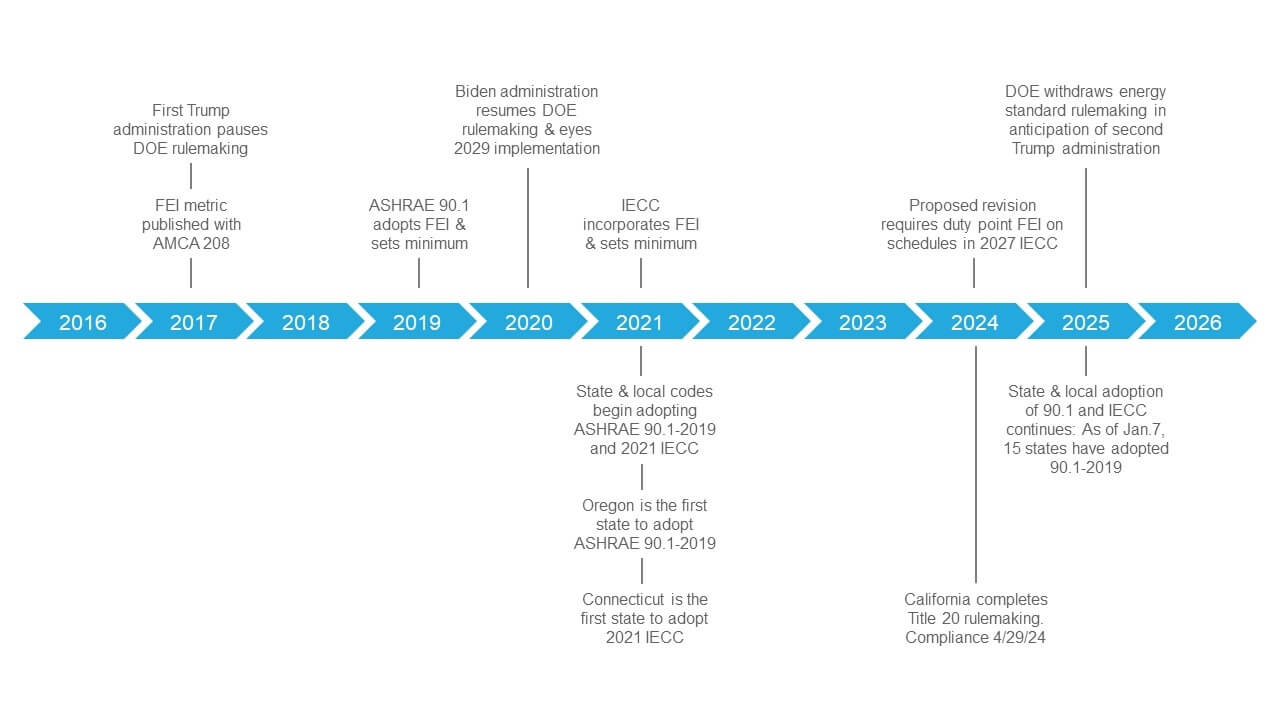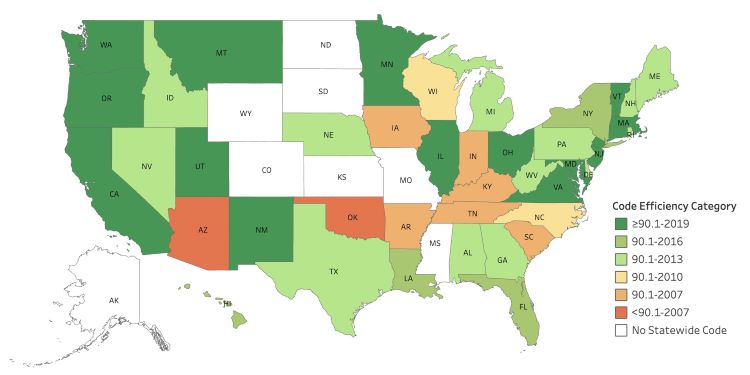Fan Energy Regulation: Where It’s Been, Where It’s Going

The energy consumed by fan systems in commercial buildings is a significant contributor to CO2 emissions, energy costs, and operating costs. According to the Air Movement and Control Association International (AMCA), commercial buildings account for 35% of energy consumption in the United States, and HVAC/R applications make up over 45% of electricity consumed in commercial buildings. The Department of Energy and professional organizations such as AMCA and ASHRAE have been engaged in efforts to set rules and standards around fan energy for over a decade.
What follows is a short history of fan energy standards and codes up to 2025 and an update on where they are headed. The timeline above provides a visual representation.
While brake horsepower (BHP) has been used as the primary metric for comparing fan energy requirements, it is an incomplete representation of the total energy a fan system consumes. BHP accounts for losses due to bearings and aerodynamic design but does not include losses from variable frequency drives (VFDs), motors, belts, or pulleys.
The Department of Energy therefore began a process of rulemaking for a new fan energy standard in 2011. This was paused in 2017 by the first Trump administration.
During that pause, AMCA continued its work and introduced the Fan Energy Index (FEI) within AMCA Standard 208.
- FEI is a ratio that compares the operating power of a reference fan to that of an actual fan at the same duty point.
- A fan system with an FEI of 1.00 is using the same amount of energy as the reference fan and a system with a higher FEI, such as 1.10, is using less energy (in this case, 10% less).
- To arrive at an FEI rating, manufacturers calculate the actual electrical input power of a fan system using a wire-to-air measurement that includes all losses between the power source and the fan’s air output and ratios that with the energy usage of the reference fan.
- This provides a more holistic measurement than BHP by including efficiency losses from belts, pulleys, motors, and VFDs, in addition to aerodynamics and bearings.
AMCA 208 defines how FEI is calculated using fan energy performance data from laboratory tests. AMCA 210 contains the test procedures for fans that go into the FEI calculations.
In 2019, ASHRAE adopted FEI. The addenda to the 2019 edition of the ASHRAE 90.1 standard included FEI and set minimum FEI values which serve as the current guidelines for design specifications.
In 2021, under the Biden administration, the DOE resumed its rulemaking using FEI as the energy metric. It also proposed that FEI requirements should vary by equipment class and planned to implement the rules by 2029.
With the publication of AMCA 214 (Test Procedure for Calculating Fan Energy Index for Commercial and Industrial Fans and Blowers) in 2021, regulating bodies and energy codes were able to incorporate a test procedure for calculating FEI.
- The International Energy Conservation Code (IECC) adopted FEI in 2021 and set minimum values. It also mandated third-party certification of FEI values.
- AMCA has the only recognized certification program for FEI.
State and local regulations including FEI also began in 2021, as jurisdictions started to adopt ASHRAE 90.1-2019 and 2021 IECC.
- Oregon was the first state to adapt 90.1-2019 by adding it to the Oregon Energy Efficiency Specialty Code.
- Connecticut became the first state to incorporate 2021 IECC.
In 2024, a proposed revision to the 2027 edition of the IECC required duty point FEI to be on fan schedules. This is significant, as the reason brake horsepower is on equipment schedules is because of an IECC requirement.
California also began requiring compliance with Title 20 appliance efficiency regulation on April 29, 2024. Title 20 affects manufacturers selling in California and includes minimum FEI values along with mandatory labeling and listings that manufacturers need to be in line with.
In 2025, in anticipation of the second Trump administration, the DOE withdrew its proposed fan energy rulemaking and will pause until it determines it has the necessary support to move forward successfully. However, FEI adoption continues to advance at the state and local levels. As of January 7, 2025, 15 states meet the energy efficiencies established by the ASHRAE 90.1-2019 standard and have adopted it into their codes.
 |
Adoption at State Level (from ) |
More and more jurisdictions are implementing 2021 IECC and ASHRAE 90.1-2019, both of which set minimum FEI values. This is expected to accelerate as attention shifts from federal regulation to state regulation. States may also draft their own addendums to energy codes that include FEI requirements. Engineers will need to stay on top of both state and municipal requirements to keep in compliance.
To avoid getting caught by your local codes changing:
- Design to the latest versions of ASHRAE 90.1 and IECC standards.
- Include and hold duty point FEI on your fan schedule with a note saying, “Fans shall meet or exceed scheduled FEI value and be licensed to bear the AMCA CRP seal for FEI.”
- Use 91����͵��’s engineer application suite, which includes FEI values, to find the most efficient fan system for your application.
Read Next


from